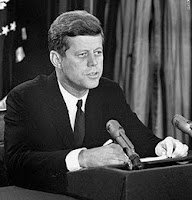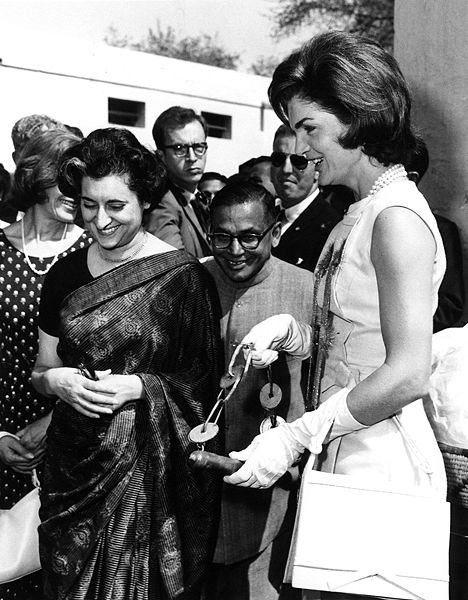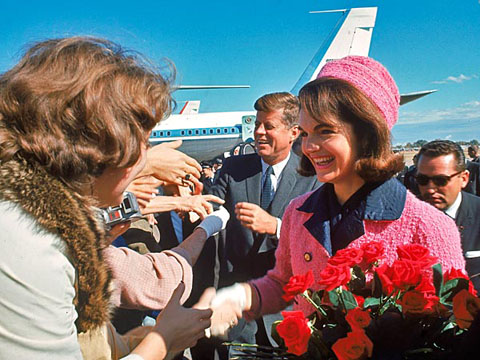In the nation's collective memory, the assassination of John F. Kennedy is a clash of images and mysteries that may never be sorted out to the satisfaction of everyone.
But if there is a lasting emblem that sums up Nov. 22, 1963, the day America tumbled from youthful idealism to hollow despair, it is Jacqueline Kennedy's rose-pink suit and pillbox hat.
An expanded collection of Kennedy treasures and trivia was unveiled this month on exhibit and online to coincide with the 50th anniversary of JFK's inauguration; it includes the fabric of his top hat (beaver fur) down to his shoe size (10C).
But missing and hardly mentioned are what could be the two most famous remnants of Kennedy's last day. The pink suit, blood-stained and perfectly preserved in a vault in Maryland, is banned from public display for 100 years. The pillbox hat — removed at Parkland Hospital while Mrs. Kennedy waited for doctors to confirm what she already knew — is lost, last known to be in the hands of her personal secretary, who won't discuss its whereabouts.
Does it matter? Should it? It's said that history takes a generation to decant, and great chapters are defined by the trappings of everyday life: a stovepipe hat, a pair of polio braces. Mrs. Kennedy could not have imagined the outfit she put on that morning would come to epitomize the essence of Camelot and the death of it.
"The single symbol of that event and of her as a persona is that pink suit," said Carl Sferrazza Anthony, a first ladies historian. "It's all anyone need see and, in an instant, people know what it is in reference to."
This is the story of how an otherwise ordinary pink suit and hat came to be treasured by a nation, only to slip from its reach.
Few public figures understood the power of fashion the way Jacqueline Kennedy did, and when she packed for Dallas, she chose nothing she hadn't worn before. The goal was not to upstage the president as she had to his delight on a recent trip to Paris, but to exquisitely accentuate him as the 1964 election season kicked off. She took along two suits, one of them the pink Chanel knockoff created by a New York dress shop so she could indulge her French tastes and still buy American.
The pink was unforgettable — the color of roses, azaleas, watermelon. Kennedy himself asked her to wear it. It was trimmed in navy blue, with a blue blouse, blue pumps and handbag, and the trademark pillbox hat, secured with a pin.
Looking back now at the grainy footage of the first couple as the dark limousine, top down, rounded the turn from Houston to Elm, it's hard not to hope for a different outcome. As long as she is wearing that hat, the world is still intact. Then, inevitably, comes the lurch of his body, the unforgettable flash of pink scrambling in panic across the trunk. All that day, her clothing bore witness to history.
Lady Bird Johnson, wife of Vice President Lyndon B. Johnson, who was riding in the motorcade's third car, recalled for investigators her memory of Secret Service agents frantic to get the president inside Parkland Hospital while his wife bent over him, refusing to let go: "I cast one last look over my shoulder and saw, in the president's car, a bundle of pink, just like a drift of blossoms, lying on the back seat."
Clint Hill, the Secret Service agent assigned to protect the first lady, remembered resting his hands on the suit's trembling shoulders, the left side of the skirt wet with blood where she was cradling her husband's head.
Somewhere inside the hospital, the hat came off. "While standing there I was handed Jackie's pillbox hat and couldn't help noticing the strands of her hair beneath the hat pin. I could almost visualize her yanking it from her head," Mary Gallagher, the first lady's personal secretary who accompanied her to Dallas, later wrote in her memoir.
Despite urgings from staff and handlers to "clean up her appearance," Mrs. Kennedy refused to get out of her bloodied clothes, according to biographer William Manchester's detailed account of the assassination, "The Death of a President."
"Why not change?" one aide prompted.
"Another dress?" the president's personal physician suggested.
Mrs. Kennedy shook her head hard. "No, let them see what they've done."
The suit was never cleaned and never will be. It sits today, unfolded and shielded from light, in an acid-free container in a windowless room somewhere inside the National Archives and Records Administration's complex in Maryland; the precise location is kept secret. The temperature hovers between 65 and 68 degrees, the humidity is 40%, the air is changed six times an hour.
"It looks like it's brand-new, except for the blood," said senior archivist Steven Tilley, one of a handful of people to lay eyes on the suit since that day in Dallas.
Half a dozen members of the Assassination Records Review Board, created by Congress in 1992 to preserve all available records for public scrutiny, were admitted to the vault for a rare glimpse, but did not consider it relevant to the crime. No other requests to see it have been granted.
Yet the suit's stamp on history is indelible for a nation that anguished at every sight of its disheveled first lady: climbing the stairs onto Air Force One to accompany her husband's coffin back to Washington, standing beside Lyndon Johnson as he took the oath of office — an iconic photo of an unexpected transfer of power fully explained by a stricken expression and a stained sleeve.
"Somehow, that was one of the most poignant sights," Mrs. Johnson later wrote in her diaries, "that immaculate woman exquisitely dressed, and caked in blood."
Despite the chaos, aides managed to secure virtually all of the Kennedys' belongings back at the White House by nightfall. The pink hat seemed to hopscotch from Dallas to Washington, according to Manchester's account. There it was in a heavy paper sack, cradled in the arms of one of the president's baggage handlers aboard Air Force One. While Mrs. Kennedy accompanied the coffin to Bethesda Naval Hospital for the autopsy, the hat made its way to the executive mansion.
A White House policeman was instructed to give it to Agent Hill, but handed it by mistake to Robert Foster, the agent assigned to protect the Kennedy children. Foster, who died in 2008, told Manchester he took the bag to the Map Room and opened it, immediately recognizing the contents.
Mrs. Kennedy returned to her private quarters of the White House in the early morning hours of Nov. 23. She took off the suit and bathed. Her maid, Providencia Paredes, told Manchester that she put the clothing in a bag and hid it.
What became of it after that speaks to the confusion and numbness of the time. A president had not been assassinated in 62 years; no one knew what to do. The Kennedy children had to be brought from their grandmother's Georgetown home to the White House and told. It wasn't even clear who should prosecute the murder — shooting the president was not then a federal crime. The first lady's attire was not exactly top priority as President Johnson figured out how to take the helm of a grieving nation.
But sometime in the next six months, a box arrived at the National Archives' downtown headquarters, where such treasures as the Constitution and Bill of Rights are kept. In it was the suit, blouse, handbag and shoes, even her stockings, along with an unsigned note on the letterhead stationery of Janet Auchincloss, Mrs. Kennedy's mother: "Jackie's suit and bag worn Nov. 22, 1963."
No hat.
The box was the one originally sent by the dressmaker, addressed to "Mrs. John F. Kennedy, The White House," but wrapped now in brown paper. Archivists put all of it in a climate-controlled vault in stack area 6W3, where it remained for more than 30 years.
"It was sort of a secret that we had it," Tilley said. Sticklers for protocol, archives officials knew it still legally belonged to Mrs. Kennedy. So it was more than a little awkward when Parade Magazine called in 1996 with a question from a reader asking what became of the pink suit.
Tilley, then head of the JFK collection, tried to reconstruct how it fell into archivists' hands. Mrs. Kennedy had been dead for two years, her mother for seven. He called everyone he could find in a position to know. No one could recall the box arriving. The single-digit postal code on the address was the only clue that it had been mailed sometime before July 1964, when the nation switched to five-digit ZIP Codes.
"It's one of the mysteries," Tilley said. "And there is nobody around anymore who can ever fill that in."
He suspects Mrs. Kennedy's mother sent it. The first lady herself exchanged letters with the head archivist in the weeks after the assassination, but there was never any mention of her suit.
"She kept it on that day, but once that moment passed, then perhaps she didn't want anything to do with it after that," Tilley said.
In the mid-1990s, the suit was moved to a new, second archives building here. In 2003, a deed of gift was secured from Caroline Kennedy, by then the sole surviving heir. She stipulated the suit not be displayed for the life of the deed —100 years. When it runs out in 2103, the right to display it can be renegotiated by the family, Tilley said.
And the hat? Agent Hill, 79, who famously lunged onto the back of the limousine that day to protect the first lady, had the answer.
"I know what happened to the hat," he said in a phone interview. "I gave it to Mary Gallagher."
Gallagher, 83, and Paredes, the maid who boxed up the clothes, together have posted for Internet auction a long list of items that once belonged to Mrs. Kennedy — a pink nightgown: $300-$400; a used tube of "Arden Pink" lipstick and some pale blue stationery: $200-$300; an unopened pack of Greek cigarettes and matchbook: $100-$200. (Mrs. Kennedy was a closet smoker.)
Reached by phone, Gallagher refused to discuss the hat.
"I don't accept these kinds of calls. Over the years they've just been enough so that I've had to draw the line.... I'm sorry. I can't help you any further," she said, hanging up.
No one at the National Archives has ever searched for the hat because it legally belongs to Caroline Kennedy. Attempts to reach her were unsuccessful.
Many of the National Archives records are open for public research, and the Kennedy assassination remains one of the three most asked-about subjects, up there with the Watergate scandal and the alien invasion of Roswell, N.M.
The archives' vast collection includes the president's shirt as it was cut off by the medical team, the tie nicked by a bullet, his white lace-up back brace. Even the contents of Parkland Hospital's Trauma Room One, where he was pronounced dead at 1 p.m. Texas time, are in a cave somewhere in Kansas.
But the whereabouts of the hat is a little-known mystery no one is working to solve; Kennedy historians contacted for this story were surprised to learn it's missing. They suspect it was sold to a private collector, or stuck away in somebody's attic, lost to the nation, a hole in history.
[END]faye.fiore@latimes.com Copyright © 2011, Los Angeles Times
 Detail” is a portrait of incredible camaraderie and incredible heartbreak, too. The book, new at the Abington Community Library, was written by Gerald Blaine, who served under three U. S. presidents as a Special Agent of the Secret Service on the White House detail, and Lisa McCubbin, an award-winning journalist. Blaine, who was a member of President Kennedy’s Secret Service team on November 22, 1963, reveals the inside story of the assassination, the weeks and days that led to it, and its heartrending aftermath. He draws on the memories of his fellow agents to capture the energetic, crowd-loving young president; the careful planning that went into his Texas trip; and the worries and concerns the agents had. Most of all, this is a look into the lives of men who devoted their entire beings to protecting the presidential family, the emotional bonds that developed, and the terrible impact on the agents and their families.
Detail” is a portrait of incredible camaraderie and incredible heartbreak, too. The book, new at the Abington Community Library, was written by Gerald Blaine, who served under three U. S. presidents as a Special Agent of the Secret Service on the White House detail, and Lisa McCubbin, an award-winning journalist. Blaine, who was a member of President Kennedy’s Secret Service team on November 22, 1963, reveals the inside story of the assassination, the weeks and days that led to it, and its heartrending aftermath. He draws on the memories of his fellow agents to capture the energetic, crowd-loving young president; the careful planning that went into his Texas trip; and the worries and concerns the agents had. Most of all, this is a look into the lives of men who devoted their entire beings to protecting the presidential family, the emotional bonds that developed, and the terrible impact on the agents and their families.














![[nielsen]](http://si.wsj.net/public/resources/images/OB-LE027_nielse_C_20101203211521.jpg)